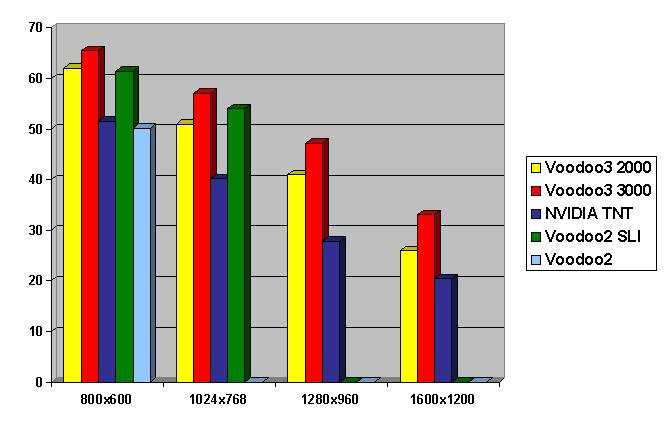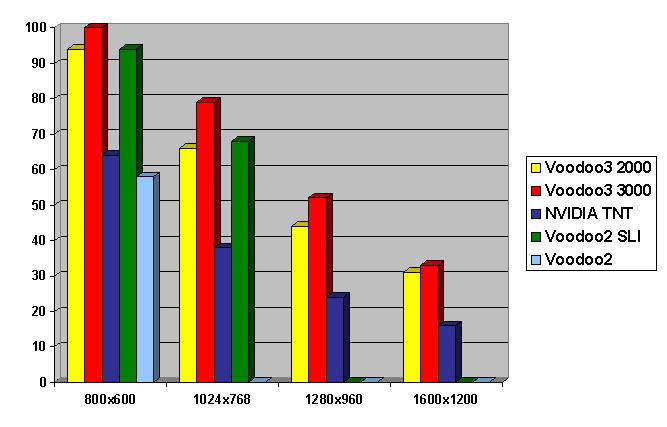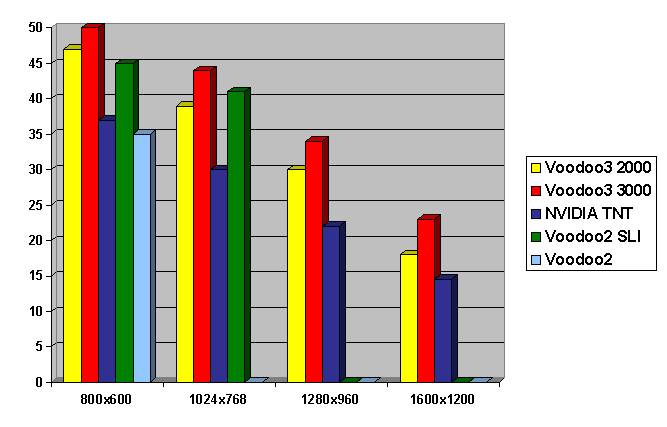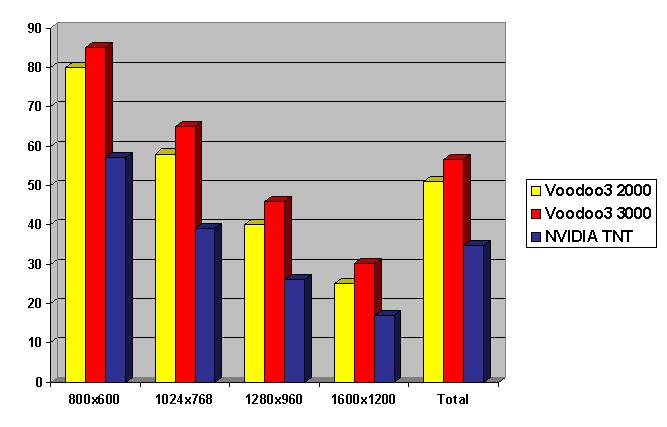 |
|
|
|
In the Forums... |
Posted: April 2, 1999 Written by: Dan "Tweak Monkey" Kennedy Estimated retail price: $129.99 Performance Test System
ABit BX6 mainboard 128 MB PC100 SDRAM Voodoo3 2000, Voodoo3 3000, Canopus Spectra 2500 (NVIDIA TNT) Drivers: Voodoo3 - included pre-release drivers (3-20-99); NVIDIA TNT - Latest Canopus drivers available as of testing date. 19" Optiquest V95 monitor VSYNC DISABLED with all cards Diamond Monster Sound MX200 Windows 98 Turok 2 T2Mark test (turok2.exe -benchmark)  Additional settings: Detail set to "High", Trilinear filtering enabled. Turok 2, a Direct3D based first person shooter, serves as a great benchmark because of the fast paced action and impressive graphics. Also, the game supports several resolutions and gives a good indication of overall 3D gaming performance. After running the benchmark at 800x600, the Voodoo3 3000 takes the number one spot. The Voodoo3 2000, which costs $50 less than its bigger brother, is right behind, and still manages to beat the Voodoo2 SLI. The Canopus Spectra 2500 (NVIDIA TNT) beats a single Voodoo2 but falls short of the others. The TNT leads the pack in visual quality at this point because it shows a somewhat sharper and more vivid image. Other than brightness, the only impact on this difference is the low resolution. At 1024x768, the Voodoo3 2000 takes a large performance hit. The card is knocked back 12 FPS, or about a 20% hit. The higher clocked Voodoo3 3000 takes a hit as well, but it still remains as the fastest card. The Voodoo2 SLI manages to take the number two spot from the Voodoo3 2000. The NVIDIA TNT card falls about the same amount as the Voodoo3 2000, and remains behind the others. The image quality difference is less apparent, yet a small difference can still be seen with blurry output on the 3Dfx cards. The 1280x960 test took its toll on the Voodoo3 2000 and TNT as well. Both cards took much larger performance hits (percentage-wise) than the Voodoo3 3000. This of course can be accounted to the massive fill rate which the TNT and even the Voodoo3 2000 cannot quite match. At this point, the game is smooth for both Voodoo3 options, but is beginning to become a little bit choppy for the TNT. The visuals are near identical at this resolution except for the brightness difference between the 3Dfx cards and the TNT. At 1600x1200, the Voodoo3 cards take huge performance hits. The Voodoo3 3000 suffers a 29% hit, but still remains smooth in the low 30s. The Voodoo3 2000 takes a whopping 40% hit and drops into the mid 20s: fairly choppy. The TNT suffers a 24% hit and is now very choppy in the low 20s. Once again, the visual quality is almost indistinguishable except brightness, which can be tweaked using Turok 2's setup options. GLQuake Timedemo 2 (timedemo demo2)  Additional settings: Joystick disabled, 16 bit color for all platforms. GLQuake is one of my favorite benchmarks because it always shows a variety in performance and visual quality. Also, it is not very CPU dependent, so the results are based primarily on video speed. The 800x600 GLQuake results differ slightly from those in Turok 2. The Voodoo3 3000 smacks into first without a problem at 126.5 FPS, leaving the others behind. The Voodoo2 SLI configuration packs a punch that knocks the Voodoo3 2000 behind, but all three of these remain far above the TNT and Voodoo2. As I stated before, GLQuake is not very CPU dependent, so the results are based primarily on video speed. This statement is demonstrated by the Voodoo2 vs Voodoo2 SLI results. If you plan to play GLQuake at this resolution, any of these cards will get the job done without problems. The visual quality in this test in definitely given to the TNT which shows very little signs of a low resolution and a less grainy display than the 3Dfx cards. At 1024x768, the Voodoo3 is still significantly faster than the Voodoo2 SLI. The Voodoo3 2000 takes a smaller performance hit than the Voodoo2 SLI, and takes its spot as the number two card. At this point, the two Voodoo3 cards are within 3 FPS of the other. The TNT remains behind. At this point, the gameplay is still solid, quick, and smooth on all cards. The visual difference is now less apparent, as the higher resolution results in less grainy output. Once again the 1280x960 test caused a large performance drop on the Voodoo3 2000 and TNT cards. The Voodoo3 2000 takes a 39% performance hit and the TNT takes a 37% hit. The Voodoo3 3000 takes a 35% performance hit. At this point the TNT started showing signs of low framerates, with a tiny bit of slowdown. The visual difference is almost non-existent now, other than the brightness factor. Now at 1600x1200, a 27% performance drop occurs when the TNT's resolution is bumped up. The gameplay is now very choppy and slow because the game has dropped below 20 FPS. The Voodoo3 3000 drops about 33% from this resolution change, but it still remains in the upper 30s and remains smooth. The Voodoo3 2000 suffers a near 40% hit, which drops the card into the low 30s. However, gameplay remains smooth, for the most part. The visual difference is now negligible. The only major visual difference is the brightness. The TNT offers a much darker, somewhat richer output. The Voodoo3 is bright (and may therefore appear "washed out") but can be adjusted to look the same with simple tweaking. Quake II Timedemo 1 (map demo1.dm2)  Additional settings: Joystick disabled, 16 bit textures, high quality sound, 16 bit color for all platforms. Quake II's least intensive benchmark, demo1, is perfect for a comparison of what single player gameplay is like at various resolutions. The action is not intense, but it offers a great variation in performance because of this. When the game is tested at 800x600, the performance follows the same pattern as the other tests. The Voodoo2 SLI is nearly on par with the Voodoo3 2000, and the Voodoo3 3000 takes a small lead. The Voodoo2 is trailing behind the TNT. As before, the Voodoo3s and SLI are far above the others. The visual difference is quite noticeable at this point because (as before) the 3Dfx cards show grainy images as a sign of a low resolution. At a resolution of 1024x768, the Voodoo3 2000 and Voodoo2 SLI take a 30% performance hit, while the Voodoo3 3000 takes a 22% performance hit. The TNT takes a huge 39% performance hit, dropping it to less than 1/2 the speed of the Voodoo3 3000. At this point, all cards are still running smooth, and the image quality difference is still notable, but not major. Now up to 1280x960, the 3Dfx cards each take a 35% performance hit, but remain smooth and consistent. The TNT drops another 40%, falling into the low 20s. The game is slow and rough at this point. The visual difference at this high of a resolution is nearly eliminated other than brightness differences, which can be tweaked. Set the resolution to 1600x1200 and even the Voodoo3s will begin to struggle. At this resolution, however, the Voodoo3 3000 and 2000 are so close in performance that it doesn't make sense to buy one over the other. Both are in the low 30s, giving borderline-acceptable performance, because this benchmark is not very intense. Once large explosions and several entities appear on the screen, the game shows major slowdowns. At 1600x1200, the NVIDIA TNT is far behind the line of crisp gameplay and is now barely making it through a timedemo. This Quake II test assures TNT owners that are happy with lower resolutions (640x480 through 1024x768), there is still no reason to upgrade for some games. The visual difference is unnoticeable except the brightness which can be changed using simple tweaking variables like gl_modulate, intensity, and vid_gamma. Quake II Crusher demo (map crusher.dm2)  Additional settings: Joystick disabled, 16 bit textures, high quality sound, 16 bit color for all platforms. The Crusher demo, designed by Brett "3 Fingers" Jacobs, is probably the most intensive Quake II benchmark available. The demo simulates a massive multiplayer match, and the action is constant. The 800x600 Crusher test levels the playing field for all cards. At this point the Voodoo3 cards are still in the lead, but only by a small margin over the Voodoo2 SLI, Voodoo2, and TNT. All of the cards can handle this test with few problems or slowdowns. At 1024x768, the Voodoo2 SLI takes the smallest performance hit: 9%. The Voodoo3 cards and the TNT take near a 20% hit. All cards are smooth, but the TNT is on the verge of running choppy. When the resolution is upped to 1280x960, the TNT becomes very choppy, in the low 20s. The Voodoo3 2000 is now on the verge of running choppy, but the Voodoo3 3000 is safe at 34 FPS. At 1600x1200, all cards are slowing down. The Voodoo3 3000 is not quite smooth, but is running much better than the others, which have dropped below the 20 FPS mark. Maybe the upcoming TNT-2 will run the 1600x1200 Crusher demo @ 30 FPS+... Overall Performance  Note: This is an average of the previous tests. Voodoo2 and Voodoo2 SLI results were excluded because they did not include all resolutions. The overall results for each card indicate what cards should be used as what resolutions. TNT users should stick with 1024x768 as a highest resolution because these tests show the framerate stays consistent (above 30) for this resolution. Thirty frames per second is what I consider to be smooth. This is why I would not recommend TNT users use a resolution of 1280x960 or above for most games. Some games will run fine at this resolution. Voodoo3 2000 users should use a maximum resolution for most games of 1280x960, which averages to 40 FPS for the tests. Because some of the 1600x1200 tests were at or above 30 FPS, this resolution could be considered acceptable for some games. Those who buy a Voodoo3 3000 could consider using 1600x1200 because most of the games ran smooth at this resolution. The Crusher demo, which takes its toll on all systems, indicates that the Voodoo3 3000 may not be optimal for 1600x1200 in intense multiplayer games, so 1280x960 should be used. |
||
|
| |||
|---|---|---|---|